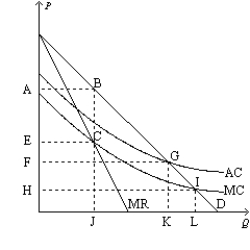A) -$6.98.
B) -$0.02.
C) $2.45.
D) $6.98.
Correct Answer

verified
Correct Answer
verified
Multiple Choice
Which of the following is an example of a barrier to entry?
A) Tom charges a higher price than his competitors for his golf lessons.
B) Dick charges a lower price than his competitors for his lawn-mowing services.
C) Harry offers free concerts on Sunday afternoons as a form of advertising.
D) Larry obtains a copyright for the new computer game that he invented.
Correct Answer

verified
Correct Answer
verified
Multiple Choice
A movie theater can increase its profits through price discrimination by charging a higher price to adults and a lower price to children if
A) adults buy more popcorn than children.
B) the cost of showing a movie to children is less than the cost of showing a movie to adults.
C) it has some degree of monopoly-pricing power.
D) All of the above are correct.
Correct Answer

verified
Correct Answer
verified
Multiple Choice
Which of the following statements is correct for a monopolist? i) The firm maximizes profits by equating marginal revenue with marginal cost. Ii) The firm maximizes profits by equating price with marginal cost. Iii) Demand equals marginal revenue. Iv) Average revenue equals price.
A) i) , iii) , and iv) only
B) i) and iv) only
C) i) , ii) , and iv) only
D) i) , ii) , iii) , and iv)
Correct Answer

verified
Correct Answer
verified
Multiple Choice
Which of the following statements is not correct?
A) Part of the deadweight loss associated with monopoly is measured by the monopolist's economic profit.
B) Marginal cost is always less than average total cost in a natural monopoly.
C) Discount coupons available free to the public are a type of price discrimination.
D) Anti-trust laws make it harder for firms to create synergies.
Correct Answer

verified
Correct Answer
verified
Multiple Choice
A profit-maximizing monopolist charges a price of $12. The intersection of the marginal revenue and marginal cost curves occurs where output is 10 units and marginal cost is $6. Average total cost for 10 units of output is $5. What is the monopolist's profit?
A) $60
B) $70
C) $100
D) $120
Correct Answer

verified
Correct Answer
verified
Multiple Choice
Table 15-21
Tommy's Tie Company, a monopolist, has the following cost and revenue information. Assume that Tommy's is
able to engage in perfect price discrimination.
 -Refer to Table 15-21. If the monopolist can engage in perfect price discrimination, what is the total revenue when 7 ties are sold?
-Refer to Table 15-21. If the monopolist can engage in perfect price discrimination, what is the total revenue when 7 ties are sold?
A) $650
B) $700
C) $910
D) $1080
Correct Answer

verified
Correct Answer
verified
Multiple Choice
Table 15-18
A monopolist faces the following demand curve:
 Suppose marginal cost is constant at $8 per unit.
-Refer to Table 15-18. The monopolist's marginal revenue from selling the second unit of output is
Suppose marginal cost is constant at $8 per unit.
-Refer to Table 15-18. The monopolist's marginal revenue from selling the second unit of output is
A) $8.
B) $14.
C) $16.
D) $24.
Correct Answer

verified
Correct Answer
verified
Multiple Choice
Economists assume that monopolists behave as
A) cost minimizers.
B) profit maximizers.
C) price maximizers.
D) maximizers of social welfare.
Correct Answer

verified
Correct Answer
verified
Multiple Choice
Which of the following statements is not correct?
A) Part of the deadweight loss associated with monopoly is measured by the monopolist's economic profit.
B) Marginal cost is always less than average total cost in a natural monopoly.
C) Discount coupons available free to the public are a type of price discrimination.
D) Anti-trust laws make it harder for firms to create synergies.
Correct Answer

verified
Correct Answer
verified
Multiple Choice
Suppose when a monopolist produces 75 units its average revenue is $10 per unit, its marginal revenue is $5 per unit, its marginal cost is $6 per unit, and its average total cost is $5 per unit. What can we conclude about this monopolist?
A) The monopolist is currently maximizing profits, and its total profits are $375.
B) The monopolist is currently maximizing profits, and its total profits are $300.
C) The monopolist is not currently maximizing profits; it should produce more units and charge a lower price to maximize profits.
D) The monopolist is not currently maximizing profits; it should produce fewer units and charge a higher price to maximize profits.
Correct Answer

verified
Correct Answer
verified
Short Answer
Figure 15-25  -Refer to Figure 15-25. If a regulator requires this firm to charge a fair return price, which letter represents the amount of output it will produce?
-Refer to Figure 15-25. If a regulator requires this firm to charge a fair return price, which letter represents the amount of output it will produce?
Correct Answer

verified
Correct Answer
verified
Multiple Choice
Because monopoly firms do not have to compete with other firms, the outcome in a market with a monopoly
A) is often not in the best interest of society.
B) maximizes total economic well-being.
C) is efficient.
D) benefits consumers more so than the producer.
Correct Answer

verified
Correct Answer
verified
Multiple Choice
Which of the following is not a reason for the existence of a monopoly?
A) patents
B) marginal-cost pricing
C) economies of scale
D) trademarks
Correct Answer

verified
Correct Answer
verified
Multiple Choice
Because natural monopolies have a declining average cost curve, regulating natural monopolies by setting price equal to marginal cost would
A) cause the monopolist to operate at a loss.
B) result in a less than optimal total surplus.
C) maximize producer surplus.
D) result in higher profits for the monopoly.
Correct Answer

verified
Correct Answer
verified
Multiple Choice
Which of the following is not a difference between monopolies and perfectly competitive markets?
A) Monopolies can earn profits in the long run while perfectly competitive firms break even.
B) Monopolies charge a price higher than marginal cost while perfectly competitive firms charge a price equal to marginal cost.
C) Monopolies choose to produce the quantity at which marginal revenue equals marginal cost while perfectly competitive firms do not.
D) Monopolies face downward sloping demand curves while perfectly competitive firms face horizontal demand curves.
Correct Answer

verified
Correct Answer
verified
Multiple Choice
If the government regulates the price that a natural monopolist can charge to be equal to the firm's average total cost, the firm will
A) earn zero profits.
B) earn positive profits, causing other firms to enter the industry.
C) earn negative profits, causing the firm to exit the industry.
D) minimize costs in order to lower the price that it charges.
Correct Answer

verified
Correct Answer
verified
Multiple Choice
Figure 15-10 ![Figure 15-10 -Refer to Figure 15-10. What area measures the deadweight loss? A) B-F) *K B) 0.5[P-O) *L-O) ] C) 0.5[A-H) *L-J) ] D) 0.5[B-F) *L-K) ]](https://d2lvgg3v3hfg70.cloudfront.net/TB4803/11eaaa28_10bc_be3a_86f9_3743144d8da6_TB4803_00.jpg) -Refer to Figure 15-10. What area measures the deadweight loss?
-Refer to Figure 15-10. What area measures the deadweight loss?
A) B-F) *K
B) 0.5[P-O) *L-O) ]
C) 0.5[A-H) *L-J) ]
D) 0.5[B-F) *L-K) ]
Correct Answer

verified
Correct Answer
verified
Multiple Choice
If the government regulates the price that a natural monopolist can charge to be equal to the firm's marginal cost, the firm will
A) earn zero profits.
B) earn positive profits, causing other firms to enter the industry.
C) earn negative profits, causing the firm to exit the industry.
D) minimize costs in order to lower the price that it charges.
Correct Answer

verified
Correct Answer
verified
Multiple Choice
The George Stigler quote, "...the degree of 'market failure' for the American economy is much smaller than the 'political failure' arising from the imperfections of economic policies ..." illustrates the advantage of which type of public policy toward monopolies?
A) antitrust laws
B) regulation
C) public ownership
D) "do nothing"
Correct Answer

verified
Correct Answer
verified
Showing 41 - 60 of 637
Related Exams